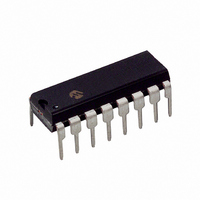MCP3008-I/P Microchip Technology, MCP3008-I/P Datasheet - Page 19

MCP3008-I/P
Manufacturer Part Number
MCP3008-I/P
Description
IC ADC 10BIT 2.7V 8CH SPI 16-DIP
Manufacturer
Microchip Technology
Specifications of MCP3008-I/P
Data Interface
Serial, SPI™
Number Of Bits
10
Sampling Rate (per Second)
200k
Number Of Converters
1
Voltage Supply Source
Single Supply
Operating Temperature
-40°C ~ 85°C
Mounting Type
Through Hole
Package / Case
16-DIP (0.300", 7.62mm)
Resolution (bits)
10bit
Sampling Rate
200kSPS
Input Channel Type
Pseudo Differential, Single Ended
Supply Voltage Range - Analog
2.7V To 5.5V
Supply Current
425µA
Lead Free Status / RoHS Status
Lead free / RoHS Compliant
Available stocks
Company
Part Number
Manufacturer
Quantity
Price
Company:
Part Number:
MCP3008-I/P
Manufacturer:
VISHAY
Quantity:
1 001
Part Number:
MCP3008-I/P
Manufacturer:
MICROCHIP/微芯
Quantity:
20 000
6.2
When the MCP3004/3008 initiates the sample period,
charge is stored on the sample capacitor. When the
sample period is complete, the device converts one bit
for each clock that is received. It is important for the
user to note that a slow clock rate will allow charge to
bleed off the sample capacitor while the conversion is
taking place. At 85°C (worst case condition), the part
will maintain proper charge on the sample capacitor for
at least 1.2 ms after the sample period has ended. This
means that the time between the end of the sample
period and the time that all 10 data bits have been
clocked out must not exceed 1.2 ms (effective clock
frequency of 10 kHz). Failure to meet this criterion may
introduce linearity errors into the conversion outside
the rated specifications. It should be noted that during
the entire conversion cycle, the A/D converter does not
require a constant clock speed or duty cycle, as long as
all timing specifications are met.
6.3
If the signal source for the A/D converter is not a low
impedance source, it will have to be buffered or inaccu-
rate conversion results may occur (see Figure 4-2). It is
also recommended that a filter be used to eliminate any
signals that may be aliased back in to the conversion
results, as is illustrated in Figure 6-3, where an op amp
is used to drive, filter and gain the analog input of the
MCP3004/3008. This amplifier provides a low imped-
ance source for the converter input, plus a low pass
filter, which eliminates unwanted high frequency noise.
Low pass (anti-aliasing) filters can be designed using
Microchip’s free interactive FilterLab™ software. Filter-
Lab will calculate capacitor and resistors values, as
well as determine the number of poles that are required
for the application. For more information on filtering sig-
nals, see AN699, “Anti-Aliasing Analog Filters for Data
Acquisition Systems”.
2002 Microchip Technology Inc.
Maintaining Minimum Clock
Buffering/Filtering the Analog
Speed
Inputs
FIGURE 6-3:
Amplifier is used to implement a second order
anti-aliasing filter for the signal being converted
by the MCP3004.
6.4
When laying out a printed circuit board for use with
analog components, care should be taken to reduce
noise wherever possible. A bypass capacitor should
always be used with this device and should be placed
as close as possible to the device pin. A bypass capac-
itor value of 1 µF is recommended.
Digital and analog traces should be separated as much
as possible on the board, with no traces running under-
neath the device or bypass capacitor. Extra precau-
tions should be taken to keep traces with high
frequency signals (such as clock lines) as far as possi-
ble from analog traces.
Use of an analog ground plane is recommended in
order to keep the ground potential the same for all
devices on the board. Providing V
devices in a “star” configuration can also reduce noise
by eliminating return current paths and associated
errors (see Figure 6-4). For more information on layout
tips when using A/D converters, refer to AN688, “Lay-
out Tips for 12-Bit A/D Converter Applications”.
FIGURE 6-4:
configuration in order to reduce errors caused by
current return paths.
V
IN
Device 1
R
Layout Considerations
1
R
0.1 µF
C
C
2
1
2
Reference
MCP3004/3008
4.096V
Device 2
The MCP601 Operational
V
R
DD
MCP601
3
+
MCP1541
-
R
Connection
4
traces arranged in a ‘Star’
V
DD
1 µF
IN+
IN-
Device 3
DD
MCP3004
DS21295B-page 19
V
REF
Device 4
connections to
V
DD
10 µF
1 µF














